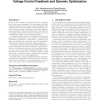8 search results - page 1 / 2 » Low-power clock distribution using multiple voltages and red... |
TVLSI
2002
13 years 4 months ago
2002
: Clock networks account for a significant fraction of the power dissipation of a chip and are critical to performance. This paper presents theory and algorithms for building a low...
HOTI
2005
IEEE
13 years 10 months ago
2005
IEEE
A partitioned TCAM-based search engine is presented that increases packet forwarding rate multiple times over traditional TCAMs. The model works for IPv4 and IPv6 packet forwardin...
DAC
2007
ACM
14 years 5 months ago
2007
ACM
Due to high levels of integration and complexity, the design of multi-core SoCs has become increasingly challenging. In particular, energy consumption and distributing a single gl...
HPCA
2005
IEEE
14 years 5 months ago
2005
IEEE
Dynamic voltage and frequency scaling (DVFS) is a widely-used method for energy-efficient computing. In this paper, we present a new intra-task online DVFS scheme for multiple clo...
ISLPED
2004
ACM
13 years 10 months ago
2004
ACM
Microprocessor designers use techniques such as clock gating to reduce power dissipation. An unfortunate side-effect of these techniques is the processor current fluctuations th...

